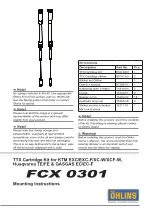
3-4
hsb
2
PLUS Series Color LCD Display
In
terpretin
g an
d
A
dju
stin
g t
he
Ra
da
r
Pi
cture
Note:
The ranges shown in the table are theoretical maximum ranges. The ra-
dar horizon is greater than the optical horizon, but the radar can only detect
targets if a large enough target is above the radar horizon.
3.3 Interpreting and Adjusting the Radar Picture
Navigational echoes may be large, small, bright or faint, depending not only
on the size of the object but also on its orientation and surface. Different
objects reflect the radar signals in different ways. For example, vertical
objects such as cliffs reflect signals better than sloping ones such as
sandbanks.
High coastlines and mountainous coastal regions can be observed at the
longest radar range. However, the first sight of land may be a mountain several
miles inland from the coastline. The actual coastline may not appear on the
radar until the vessel is close to the line of sight distance.
The radar indication may not be similar to your visual observation; a nearby
small object may appear to be the same size as a distant large object on the
radar. However, with experience the approximate size of different objects can
be determined by the relative size and brightness of the echoes.
Some targets, such as buoys and small boats, can be difficult to differentiate,
since they bob and toss about in the waves and do not present a consistent
reflecting surface. Consequently, these echoes have a tendency to fade and
brighten and, at times, to disappear momentarily. Buoys and small boats often
resemble each other, but boats can usually be distinguished by their motion.
Not all radar echoes are produced by hard navigational items. Some echoes
may be received from irregularities on the surface of the water, particularly at
close range (sea clutter), or from rain or snow either around the vessel or in the
distance. In addition, some echoes may be indirect returns to the radar scanner,
providing false echoes or multiple echoes.
The effects of many false echoes can be minimized, and the target presentation
clarified using the controls summarized below. This section explains how to
interpret the radar picture and how the controls affect the display. It provides
instructions for adjusting the settings, describes the circumstances in which
they should be adjusted, and how they interact with each other.
Summary of Contents for hsb2 PLUS Series
Page 4: ......
Page 16: ...xiv hsb2 PLUS Series Color LCD Display...
Page 70: ...2 34 hsb2 PLUS Series Color LCD Display Displaying the Radar and Synchronizing Radar Chart...
Page 158: ...6 12 hsb2 PLUS Series Color LCD Display Data Log Mode...
Page 210: ...8 32 hsb2 PLUS Series Color LCD Display Transmitted Data...
Page 232: ...C 6 hsb2 PLUS Series Color LCD Display C MAP Chart Card Features...
















































